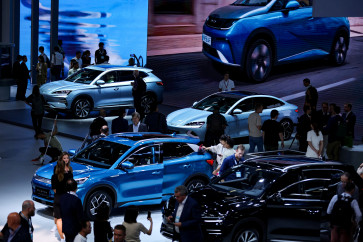Popular Reads
Top Results
Can't find what you're looking for?
View all search resultsPopular Reads
Top Results
Can't find what you're looking for?
View all search resultsThree paradoxes of digitalization
The digital economy, e-commerce in particular, is driving growth in ASEAN, which is emerging as a promising region in view of the increasingly saturated Chinese market
Change text size
Gift Premium Articles
to Anyone
The digital economy, e-commerce in particular, is driving growth in ASEAN, which is emerging as a promising region in view of the increasingly saturated Chinese market.
An e-commerce boom is rapidly unfolding in several ASEAN member states, including Indonesia, Thailand, Myanmar, Singapore, the Philippines and Vietnam. A 2016 report titled “E-Conomy SEA (Southeast Asia)” by Singaporean sovereign fund Temasek and Google pegs e-commerce in ASEAN to rise to US$8.78 billion by 2025. The portion of e-commerce to retail sales in the region is also projected to jump to 6.4 percent by 2025 from only 0.8 percent in 2015.
However, amid the flourishing e-commerce, a contrasting trend is also emerging. Some e-commerce companies in ASEAN are beginning to realize the importance of creating offline experiences for shoppers. Moving beyond the conventional cash-on-delivery model, Zalora, a Singapore-based online fashion retailer, offers a unique payment method.
The website provides a cash-on-collection option, a concept that has already gained popularity in Taiwan and Japan. Collaborating with some convenience store chains, Zalora gives its customers the option of picking up and paying for their items at an outlet of their choice. They have also started erecting pop-up stores across shopping centers to educate shoppers and encourage them to use their apps.
This represents one of the paradoxes occurring as a consequence of digitalization in ASEAN. For businesses, to win over competition in this new digital era, the three paradoxes described below need to be understood and managed appropriately.
Internet technology does provide convenience and high efficiency. The interaction between company and customer can take place anytime and anywhere. That has prompted companies in ASEAN to flock to the online world, build their official websites, nurture online communities and designate special social media teams to build and maintain relationships with customers. But as a matter of fact, the online world has its own limitations, which means that the conventional approaches of the offline world cannot be completely replaced.
The initiative of an online retailer like Zalora to go offline via a cash-on-collection option and pop-up stores is an example of how businesses are striving to make offline and online shopping work together seamlessly. Neither option is mutually exclusive. In fact, in the near future, perhaps we can stop comparing Zalora and the likes to traditional, brick-and-mortar, offline retailers. There will just be “shopping” and it will be an integrated online and offline experience.
The internet’s development has also created new patterns of information consumption. While in the print media readers have conventionally been familiar with a writing style that is more elaborate, focusing on features and in-depth stories, those who read online news sites are more accustomed to shorter, crisper write-ups. This is why visual factors — images and illustrations — serve to improve the design, frequently used by content providers to develop more engaging online content.
Paula Ries (2012) in the book Visual Hammer even stressed the importance of the visual aspect as a verbal positioning booster to inculcate a certain perception in the minds of customers. This is a trend in the digital world that requires producers to include style in the developed content.
But of course, the company cannot rely solely on style aspects (visuals, audio, design, etc.) to provide information that touches customers rationally and emotionally. The substance of their digital content should also be weighted. This is what presents the need for content producers to balance both: how to create content that is concise and interesting, yet still does not lose its core substance.
For example, the makers of video advertisements on YouTube must be creative enough to design a message that attracts viewers’ attention within the first five seconds, so that they do not skip the video. That is where style is factored. But ultimately it is the compelling message that conveys the desired information about the advertised product effectively, and that is what we call substance.
Digitalization has enabled interaction between various technology products. Existing data on our handsets can be transferred to other technological products in the form of instructions that produce a specific action or output. This is what is known as the Internet of Things (IOT) or Machine-to-Machine (M2M) technology.
A range of new wearable devices has come onto the market over the past years, including the Samsung Gear and the LG Lifeband. Connected devices and sensors allow customers to adopt a smarter, more efficient and convenient lifestyle, with their personal devices such as smartphones and tablets connected to devices in their homes to enable automation. Samsung Electronics has announced that 90 percent of its products — everything from smartphones to refrigerators — will be able to connect to the web by 2017.
But technology does not make man into a machine without emotions. Instead, digital technology, particularly social media, has turned customers into more emotionally expressive beings. This is why the human-to-human (H2H) touch must not be forgotten. Technology must be optimized to create a human-to-human interaction that is more flexible (not constrained by space and time), and not create a different space that ends up replacing the precious conventional ways of interaction.
These are the three paradoxes facing businesses today, all of which can actually be managed simultaneously, without having to negate each other. But it requires creativity to build an integrated online-offline experience, develop content that has substance with style, as well as machine-to-machine (M2M) technology supported by the human-to-human (H2H) touch.
A company’s success in managing these three will create a strong competitive advantage to win the minds and hearts of digital consumers in Southeast Asia.
_____________________________
Hermawan Kartajaya is founder and chairman of MarkPlus, Inc. Ardhi Ridwansyah is director of EMBA SBM-ITB/MarkPlus Institute.










